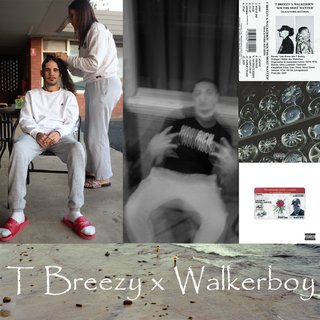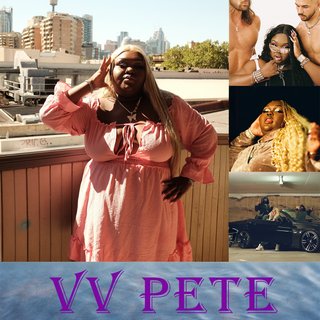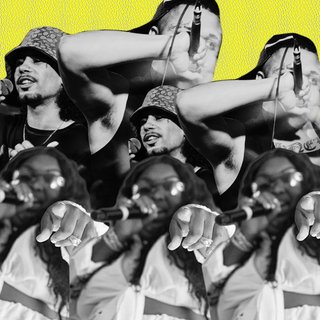You’re on Part 2 of Playing the blues – if you haven’t yet, read Part 1 here:
It’s 4:30pm, seven hours until showtime: time for a fade. In the carpark of the Royal Hotel Motel (that’s its real name) in Inverell, Walkerboy is giving a relative a buzzcut. He’s friendly, joking around, but focused too; locked in. Chilling in a plastic chair, said relative is one of the first to arrive. Over the next few hours, dozens of close family and friends, not only local but from regional towns all over NSW and the near QLD border, will descend upon that asphalt staging ground (that sort of classic motel horseshoe type set up that lets everyone hang out outside their rooms) for hours of laughter, years-gone-by reunions, and passionate discussions about best regional pie shops, something called Motor Mania Sunday, and the local rugby league grand final, in which the referee ripped off an (admittedly scandalous, if true) 10-0 second half penalty count.
“It was even more than that!” someone chips in, as T-Breezy takes his turn in the plastic chair, a close confidant beginning to braid his hair. As more people rock up, these sorts of interjections often interrupt Breezy as he talks – “everyone talking about this night, brah, word,”– but he’s ever-patient, meeting each new arrival with a genuine warmth. Affable to those around him and thoughtful in his responses to questions, that quiet kid from the shed in Blacktown now carries a quiet confidence.
It’s a major occasion: T-Breezy and Walkerboy’s first ever hometown show in Inverell, celebrating the release of Souths Most Wanted. It’s a mixtape that itself immortalises the ‘Southside’ part of the town where the duo are from, with Breezy explaining the intention to rep Southside in the way “Onefour reps Mount Druitt, or Kerser reps Campbelltown”, claiming that part of the town as important; demarcated and tight-knit.
“Most of the time, people on South are literally just cracking laps just to see what's going on. They're listening to everybody. Like, if I go down to Southside right now, there's not a whole lot of houses that I couldn't just walk into and make a feed, or just make myself at home.”
That genuine community is felt in the energy leading p to the pair's performance. For Walkerboy, it means a lot to see hangouts and basketball shootarounds around Inverell now bumping his own music.
“I think I give them a strong deliverance bro. Because they really do lock in and listen to what I'm saying.”
Unlike Breezy, he doesn’t write his bars but mostly freestyles in the booth.
“I just get pumped and… shit. I get in my zone. I've got to switch – when it comes to certain shit, if I'm rapping about, like… past things – I've got to switch over into my old self. Because it's a different person.”
There’s not many rappers like Walkerboy in Australia, with his totally smooth but barrelling flow. He zags away from the safe trap or drill production common in the scene, instead holding 50 Cent and DMX as close influences. Throughout his discography he draws on both those artists; not only their intensity but the sonic variety of their best records – the Memphis-style phonk of ‘CHIT CHAT’ being particularly inspired:
“[UTILITY] calls it fruity, but I reckon it's just flavour, you know, like 50 Cent. That's gangsta, brah. It's groovy, it's funk.”
Souths Most Wanted is a rollicking combination of both brother’s styles: “complete opposite, but we get along like the house on fire,” as Breezy describes it. A culmination of a lifelong dream but also a classic hip-hop ‘coming back to and grappling with your hometown’ debut, it’s a story not really told before in the history of “Australian” hip hop – two young Gamilaraay men grappling with the specificities of rural life on this continent in the 21st century.
“We were just moving to Sydney, and we wanted to start feeling at home a bit. So, yeah, we just kind of stopped talking to everybody [from Inverell]. But, man, you can always come back here, and we just… [pauses] we call it getting stuck here, but... we choose to stay. [laughs]”
Outside of Southside, Inverell is very much a classic rural ‘Australian’ town, the Royal Hotel Motel its centrepiece: strange cowboy saloon aesthetics, sun-faded Bundy Bear sign greeting you at the entrance, racially incentive decorative statues within. “Oh you’re here for the…?” the bartender raises her eyebrow, two knots away from suspicion. But there’s also, somehow, a fully decked out, probably often unused but gleefully dB-unsafe club space smack in the middle of the main pub and restaurant. A packed room of pre-teen-to-post-retirement supporters cheer on, dancing and bobbing on a strobing-rainbow panelled dancefloor; less Saturday Night Fever and more level one million on Tetris (this place literally sicker than literally any venue in Sydney).
On the main stage, T-Breezy and Walkerboy trade verses. A huddle of beaming friends and phone flashlights illuminate them (there’s about five Instagram Lives going), rapping along with grins on their faces. Some are as young as T-Breezy was when he first started rapping, something on his mind.
“I've got a feeling there's got to be some young followers in here that probably want to do it. Like, I personally want to bring a studio back here just to see if anyone actually wants to do it.”
Walkerboy has also come back to Inverell with a renewed perspective and purpose.
“It’d be good to show all the young little fellas that there's better c**nts than what they're looking at. You know?”
It’s a sense of responsibility and kinship born from the relationships both rappers built with their TRACKWORK “family.” BAYANG (tha Bushranger) is as important to Walkerboy as he was to T Breezy all those years ago.
“I don't even know how to explain it, man. [BAYANG]’s just a unique person, bro. He's mad... I would say…[pauses] He dragged my head out of the gutter, for me thinking stupid, and I started to think a little bit better about shit. And, probably, I didn't even realise that myself until now. But he's a real good mate.”
Those relationships are still fiercely important to BAYANG.
“I miss the days where we have an excuse to hang out every weekend. And now things get busy and we don't see each other as often, but I love those two so much, you know? And just witnessing them from a distance, f**k, like you're just so proud. Like, not just in a brotherly way, just in this broader, like, this is us. This is a form of cultural expression that I can throw my whole f**king body weight behind.”
Similarly with Austin – Walkerboy describes him as the ‘dad’ of the group.
“He breathes music. I don't even know if he watches football, he'd probably go home and watch f**king The Voice. [laughs].”
BAYANG also admires Austin’s skill to make beginners sound like they’re “on top of the world’ – something that did “wonders for our confidence.”
“He was able to find that thing in Breezy that maybe he wasn't a hundred percent aware of at the time. And draw it out and be like, ‘Look at that. That's f**king special. Now value it.’ ”

Featured releases: Souths Most Wanted (2024), On A Roll (2022), 2360 (2019)
A legacy of Sydney DIY and independent music inspired Austin to start TRACKWORK – Cassius Select, Marcus Whale, Shoeb Ahmad among others. But Breezy’s drive was the spark that kicked it all off.
“He was super driven and kept asking me, “where the hell do I release this?” And I never really had a response for him. I just could never really say [at] what kind of major label, this kind of left field, more risk taking, kind of pretty experimental rap we were making would sit. Like it wasn't commercially viable music.”
2360 and notfromhere were followed by an infamous mixtape with Snoee Badman; but it’s Vv Pete that raised TRACKWORK to a new level. The Mount Druitt raised rapper originally started by freestyling on social media. She had interest from a few producers at the time, but none committed to a release – they were, as she puts it, “wasting my time.” Whilst in a program at local youth organisation The Street University, her mentor Esky rang her up one day out of the blue: OneFour were coming through.
“I didn't even hesit te. I had no time for makeup. I just put on my trackies.”
Austin was just one of the emoji comments on that soon-to-be viral video of Vv freestyling. A few patient meetings later, Vv knew she’d found something.
“I really was very disciplined with what I wanted. And TRACKWORK laid out on the table what they were after. And through time, I was just seeing the consistency, dedication. I'm like, this is it. This is what I've been looking for.”
Vv Pete is someone with vision. She coined her own nickname in highschool (“like, I love my name, but it's so long, can I cut it short?”) and knows exactly the type of artist she wants to be, and how to get there. “You need a signature dance, and you need a signature ad-lib.”
A masterful songwriter with an unmatched hook game, her songs have a deceptively delicate construction. There’s a lot of moving parts to a song like ‘Jordan 1s’: a jersey-drill slammer on the surface, but one with constant subtle changes in flow and tone. As she talks about her songs, you can see the ideas racing through her mind, arms waving, drawing on threads and puzzle pieces in the air.
“I don't feel comfortable at all with a track just sounding straight… it's all about being able to show variation for me.”
Vv Pete’s music is totally unique amongst most pop-leaning sounds in contemporary ‘Australian’ hip-hop. Compare that viral freestyle to her hit song ‘Frauds’ – the same verses, reworked three years later. The original, fairly typical drill beat has become something sleek and dangerous, a better match for Vv’s eyes narrowed, cheekily villainous voice. Something that sounds like a swarm of bees doing a burnout in a carpark slices in and out of the song, and a throwaway line from the freestyle has now become a hitmaker’s dream hook, “Them girls is frauds / Copies of Vv Pete of course.” To Austin, not many can replicate what she’s doing.
“She consistently amazes me. I have to zoom out sometimes and be like… how did you even think of this structurally in this way?”
The pair have built a formidable working relationship, one built on a genuine friendship; something Vv speaks of with pride.
“It kind of showed me, someone can want you when you're a product, but it's all about, how much do they really believe in you? You want to surround yourself with people that would invest in you because they believe in you.”
Vv Pete has built a loyal local fanbase (her “Vvarvies”), and the club-ready nature of her tracks has gained her specific support across queer and dance music communities. When Vv and Austin interpolate dance music genres, be it qom or baile funk, it never feeds trend-chasing; Vv’s structural creativity and willingness to push boundaries mean that throwaway ideas based on influences of Austin’s, be it Formation Boyz or d.silvestre, become hits.
“V would find the weirdest stuff on my hard drive and just be like, ‘Oh, what's that? Let me try something with that,’ and then it would just spiral into something completely new.”

Featured releases: Bacardi Papi (2023), Jordan 1s (2023), Frauds (2022)
Her freshness and desire to sound different makes Vv Pete an easy figure for Sydney to rally behind. Building and running an independent label alongside Vv and the other artists on TRACKWORK hasn’t been easy for Austin, but it’s clear to him that there was a real desire for new sounds and voices in ‘Australian’ hip-hop that weren’t being represented.
Working in the scene over a number of years, he’s watched the industry struggle to shrug off an often commercial, mostly white male, millennial-era, boom-bap sound. Often coined larrikin or ‘barbeque’ rap, Austin says the latter is a “surprisingly controversial term,” and while he doesn’t discount the legacy of some of its earliest artists, he agrees that it didn’t prioritise who “should be at the forefront” of the scene.
“And please emphasise no shade but, you know, it's music that was still catching up to the internet. And unfortunately, I think stylistically it fell short.”
When Teether and Too Birds were first exploring their experimental sound in the mid-to-late 2010s, ‘barbeque’ rap still dominated.
“Back then, we were basically playing in the suburbs… like eight white guys on stage playing 45 minutes after each other, just like hype beat, you know. It was intense. And then we'd get up on stage and it'd just be like “who the f**k are these guys? What the f**k is this music?” People just staring at us.”
Some things have changed since then – Tkay Maidza, Sampa the Great and Genesis Owusu are examples of organic success stories that gained enough support to build an audience both at home and overseas. And a number of pioneering First Nations rappers like BARKAA are finally getting the mainstream success they deserve, a small recognition of industry understanding that these are the voices audiences actually want to hear.
But the lack of support for a healthy undergrowth has meant that even when organic underground scenes break though, such as the drill explosion of groups like OneFour and HP Boyz, nothing is left to re-energise the scene sonically when those artists ascend to more commercial sounds and successes. That first small step of recognition, or reliable sense of modest support for underground artists, seems harder than ever. It’s frustrating for a prolific artist like Teether, who’s released more than 12 full length projects in the last decade. For him, the industry still feels “quite out of touch with modern sounds,” and “needs to be told that something is good before they will listen to it and embrace it.”
“New sounds are being developed and born, played in venues, in communities that they don't walk into….They want to get black people to perform on stage, but they don't want to get them in the office and talk to them because they're scared… they're not really trying to understand us.”
Internationally, modern hip-hop is as fluid as it’s ever been, constantly moving and reinventing itself with new sounds and new ideas. But at times the ‘Australian’ scene gives off a sense of lag; an aversion to new sounds and desire to look overseas, even then in a belated way. BAYANG clocks this as indicative of a bigger, “central contradiction in Australian society” – a “cultural crisis.”
“If you get down to the core of it, Australia itself doesn't have much of a solid identity, right? It's a mongrel culture… And the foundation underlying all of it is genocide. So there's no kind of unproblematic link between the very roots of this country and what's happening now.”
In this way, the institutional problems across the arts industry (sporadic government support, cost of living pressures, industry and live music venue inaccessibility, to name but a few), are recontextualised as intensifications of dynamics inherent to broader ‘Australian’ society, moulded by its history and legacy as an ethno-state; an imported cultural consciousness of ‘terra nullius’ and severe capitalist discipline. Don’t be weird, and don’t step out of line – and be wary of anything that does.
Released in these conditions, records like It Must Be Strange… or REDBRICKGOTHIK inevitably cut close to the bone. Culture, music especially, always starts from below and funnels up, but these records feel like desperate gasps for air, signal blasts of ‘I was here’ across a scene that feels frozen in time. Laced with hope and the potential for change, because that ‘mongrel culture’ does exist, so why not embrace it? If you’re making hip-hop in this country of all places, why not create a sonic world that confronts that? For BAYANG, it’s an exit ramp. Take a risk, have some style. Embrace the reality.
“Hip-hop is somewhere where you have to be real, right? You have to kind of be as honest as possible. Even when it's uncomfortable or embarrassing. But I love it for that.”
Playing the blues concludes in Part 3 - read on here
Words by Lindsay Riley. Graphics by Rafael Enriquez
